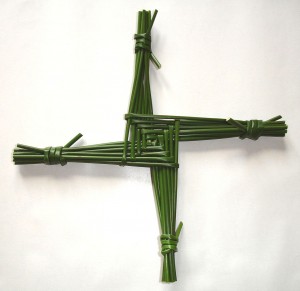This website uses cookies to help deliver its services. By using this website, you agree to the use of cookies as outlined in our Privacy Policy.


As Storm Brigid passes over Ireland leaving a trail of demolition and floods in her wake, it got me thinking about the name of the storm and its links with the Irish female patron saint.

History
St Brigid, like Patrick, was a blow-in to Ireland. She started off as a Scottish slave in Louth in the 5th century and ended up as one of the most powerful saints of Ireland, known as the Mary of the Gaels. Unlike a lot of saints, Brigid was born holy, with a flame coming out of her head. Miracles were second nature to her and they usually involved simple stuff like multiplying food, which was always going to go down well in agricultural societies. As a result she quickly went from slave to leader of a powerful convent which contained a sacred flame that was kept lit by nuns for centuries.

Legend
In typical Irish tradition, Brigid is connected to the other Irish Brigit who was a classic triple goddess of the Celtic pagan world. This older Brigit also happened to be associated with fire, changing seasons and animals. Her day of worship was Imbolc which means “the belly” and it refers to the lambing season. Imbolc usually falls at the start of February. Brigit was the daughter of the Dagda who lives at Brú na Boinne, so she is technically a meathwoman.
Locations
Although she was born in Louth, St Brigid has lots of connections to the Boyne Valley. There are four Kilbrides in Meath which are named after the saint. The Hill of Tara also has another connection with the pagan Brigit through the sunrise event which lights up the Mound of the Hostages in February. There is also a tradition of a pilgrimage which goes through the Boyne Valley every year from her birthplace to Kildare. Outside Ireland, Brigid is also remembered. Like Columba and Patrick, she travelled a lot. Glastonbury claims her, as does Brittany. The English placename Bridewell refers to water sources that had her curative powers, while the number of Kilbrides in Scotland are probably in honour of her origins.
Folklore
Every Irish kid makes a Brigids cross in school. Tradition has it that they were made from rushes handpicked on New Years Eve and stuck up on the rafters of thatched cottages to protect against fire. They are now made with anything from pipecleaners to ice-pop sticks and they are stuck on fridges along with crayon drawings. They still herald the start of the Spring Cleaning season. For us this means getting out on the river and cleaning away the debris from the floods, and power hosing the winter off the high rope platforms.

Weather
According to tradition, the weather on Brigids Day is an indicator of whether the winter is going to turn or whether it is going to deepen. During the winter, Brigit is in her old woman persona. She is at her turning point, the cross quarter day. On Brigids Day, she will either get up out of bed and get some wood for her fire or she will stay in bed and fall asleep. If it is good weather, she will go looking for wood. If it is bad weather, she will stay where she is, like all sensible folk do. Judging by yesterdays weather, she should be snoring away and Spring should be making an appearance soon. Either way, it is time to get out and about.


